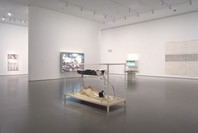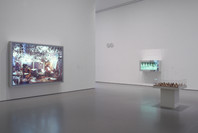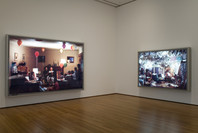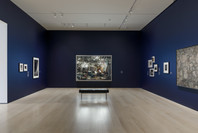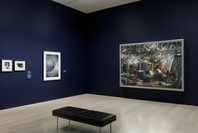After a brief but eventful career that embodies the hopes and humiliations of African Americans at mid-twentieth century, the hero of Ralph Ellison’s celebrated 1952 novel Invisible Man retreats to a secret basement room on the edge of the Manhattan neighborhood of Harlem. There, in the novel’s eloquent prologue, he patiently composes and reflects upon the story that follows. “I am invisible, understand,” he explains, “simply because people refuse to see me.”
Making pictures out of stories was once the main business of the visual arts. The rising modernist tradition consigned the practice to the margins; for most of the past century, “illustration” has been a term of contempt. In this large, richly detailed and thoroughly absorbing photograph, Wall has all but single-handedly reinvented the challenge.
The novel’s prologue is short on specifics, except one: 1,369 light bulbs cover the ceiling of the narrator’s underground lair. Starting with this fantastic detail, Wall scrupulously imagined in his Vancouver studio the concrete form of Ellison’s metaphorical space. Ambitiously reviving a forgotten art, he made visible the Invisible Man.
Publication excerpt from MoMA Highlights: 375 Works from The Museum of Modern Art, New York (New York: The Museum of Modern Art, 2019)
Jeff Wall based this elaborately staged photograph on the prologue of Ralph Ellison’s celebrated 1952 novel, Invisible Man. The novel’s protagonist, an unnamed African American man, relates that he lives secretly “in my hole in the basement,” where he has “wired the entire ceiling, every inch of it” with 1,369 lights powered by illegally siphoned off electricity. In addition to the prologue, Wall drew from other parts of Invisible Man and his own imagination to create this scene. His intention was not to make a literal illustration of the text, but to give form to the picture it inspired in his mind, which he calls “accidents of reading.” As he has explained, many of his images begin “from accidents in the street—events I witnessed by chance. These pictures are like that, except that the accident occurred when I happened to be reading a book. I had the same feeling reading […] that I have had many times when seeing something occur on the street or in some other place, a feeling that an opportunity for a picture was presented to me.”
Wall refers to his method of photography as “cinematography.” Similar to the process of making a movie, his work is dependent on collaboration with a cast and assistants who help him to develop his painstakingly constructed sets. He uses a large-format camera with a telephoto lens to achieve the high resolution and fine details that characterize his prints. This photograph, like most of the artist’s work, has been printed on a transparency and mounted in a steel-framed light box. The large-scale image is illuminated from behind by fluorescent lights, which Wall began utilizing after seeing light-box advertisements in the late 1970s.


